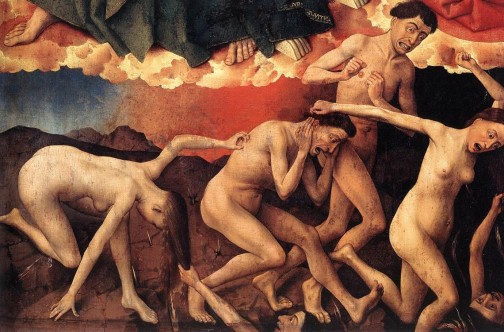
Rogier Van der Weyden, 1446. detail, The Last Judgement. Oil on wood.
“You have to hand it to them. The United States media machine is unequaled at producing and disseminating misinformation. It begins in the bowels of the State Department or White House or Pentagon and is filtered out through the government’s front organizations, otherwise known as Mainstream Media (MSM).
In 2014 the U.S. has succeeded in demonizing Vladimir Putin and Russia, precipitating a New Cold War that may yet become a hot one. The evil empire is back. The White House has made proficient use of mass media propaganda to get the job done. First, they’ve controlled the narrative. This is critical for two reasons: one, because it permits the White House to sweep the February coup in Kiev into the dustbin of American memory, never to be seen again. Second, it has allowed it to swiftly assert its claim that Russia is a dangerously expansionist power on the edges of a serene and peace-loving Europe. In other words, the omission of one fact and commission of another.”
Jason Hirthler
“Indeed, it is most significant for our discussion that the beginnings of cinema coincided with the giddy heights of the imperial project, with an epoch where Europe held sway over vast tracts of alien territory and hosts of subjugated peoples.”
Ella Shohat, Robert Stam, “Imperial Imaginary”
“Whenever you find yourself on the side of the majority, it is time to pause and reflect.”
Mark Twain
“In the current state of things, the electoral successes of the extreme right stem from contemporary capitalism itself. These successes allow the media to throw together, with the same opprobrium, the “populists of the extreme right and those of the extreme left,” obscuring the fact that the former are pro-capitalist (as the term extreme right demonstrates) and thus possible allies for capital, while the latter are the only potentially dangerous opponents of capital’s system of power.
We observe, mutatis mutandis, a similar conjuncture in the United States, although its extreme right is never called fascist. The McCarthyism of yesterday, just like the Tea Party fanatics and warmongers (e.g., Hillary Clinton) of today, openly defend “liberties”—understood as exclusively belonging to the owners and managers of monopoly capital—against “the government,” suspected of acceding to the demands of the system’s victims.”
Samir Amin
I was thinking a lot this week about Samir Amin’s essay in Monthly Review. http://monthlyreview.org/2014/09/01/the-return-of-fascism-in-contemporary-capitalism/ And I wanted to think about this topic of fascism in light of media and culture today. The video of (alleged, and more on that in a minute) the beheading of journalist James Foley (and now the Sotloff follow up sequel…though it might have been a prequel, we aren’t sure), was representative of a new cinema of violence that is the currency of political discourse today. And secondly, I wanted to discuss writing, and art in light of all this.
“the virtual library of videos and other imagery the U.S. generated, images widely viewed (or heard about and discussed) with no less horror in the Muslim world than ISIS’s imagery is in ours. As a start, there were the infamous “screen saver” images straight out of the Marquis de Sade from Abu Ghraib prison. There, Americans tortured and abused Iraqi prisoners, while creating their own iconic version of crucifixion imagery. Then there were the videos that no one (other than insiders) saw, but that everyone heard about. These, the CIA took of the repeated torture and abuse of al-Qaeda suspects in its “black sites.” In 2005, they were destroyed by an official of that agency, lest they be screened in an American court someday. There was also the Apache helicopter video released by WikiLeaks in which American pilots gunned down Iraqi civilians on the streets of Baghdad (including two Reuters correspondents), while on the sound track the crew are heard wisecracking. There was the video of U.S. troops urinating on the bodies of dead Taliban fighters in Afghanistan. There were the trophy photos of body parts brought home by U.S. soldiers. There were the snuff filmsof the victims of Washington’s drone assassination campaigns in the tribal backlands of the planet (or “bug splat,” as the drone pilots came to call the dead from those attacks) and similar footage from helicopter gunships. There was the bin Laden snuff film video from the raid on Abbottabad, Pakistan, of which President Obama reportedly watched a live feed. And that’s only to begin to account for some of the imagery produced by the U.S. since September 2001 from its various adventures in the Greater Middle East.”
Tom Engelhardt

Christophe Jacrot, photography.
So, given the rather obvious need that the imperialist West, the U.S. and it’s lackies, have for an enemy truly worthy of 3D technicolor splendour and A-list production values– the only kind that might whip up public opinion in favor of more war, the IS appears right on cue. The Foley video of course raises a lot of questions. First off, it looked like an out-take from Act of Killing, the pseudo documentary made last year starring former Indonesian death squad leaders. In fact both videos are oddly well shot, edited, lit. Most IS stuff is closer to those soft core porn channels you get in Hotel rooms.
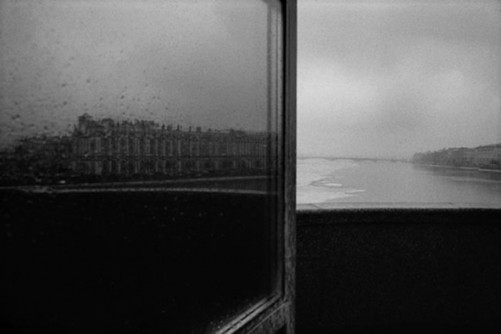
Klavdij Sluban, photography. “Trans Siberia.
“In historical struggles one must distinguish…the phrases and fancies of parties from their real organism and their real interests, their conception of themselves from their reality.”
Karl Marx, The Eighteenth Brumaire of Louis Bonaparte
The damaging influence of pop-politics, the mainstream media, Hollywood, and the faux alternative press, are useful to look at, I think, in terms of Marx’s 18th Brumaire. The invention of a discourse free from discussions of class now towers over all others, and it frees up a new branded anarchism that appeals to the hyper alienated bourgeois of today. Sample leftism. This is hipster anarchism. And its appeal isn’t hard to understand, at least for Americans and British white lads, for it is class deficient. This harkens back to basic notions of state and authority, or power. Now I’m always a tiny bit suspicious of the word ‘power’. I use it myself, but with caution. And this is because it is too vague and abstract. It sounds metaphysical. But it also goes back to ideas of the State. And this is too big a topic for this posting, but Marx is often misread in terms of his ideas on the transitional state. Lenin was very clear, however. The anarchists rejected this for…well, anarchy. Now, its true that a certain fetishizing of the industrial proletariat occurred with Marx and Engels, but the real relevance for today is that anarchism too often is simply gleanings from back pocket paperbacks of Foucault. Or not even.
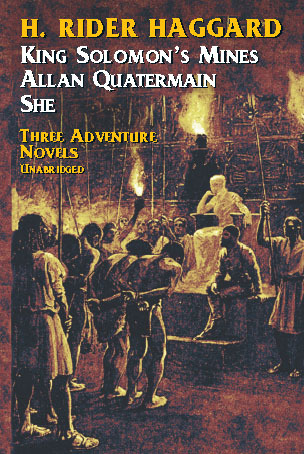
The point here is that class is a determining factor in Western society. In the Arab world, it is the relationship to colonialism. Now these new execution videos demand a certain glance backward, for film was born at the moment of Imperialist/colonialist power, the zenith in a sense of European colonial power in the form of the U.S., Germany, France, and the U.K. The democratization of reading was growing as was the idea of leisure reading, and the Penny Dreadfuls and Dime novels were largely occupied with white superiority, and with the evils of Asian perfidy. I’ve said before that the faux journalists of VICE, their so called conflict journalists are nothing but 21st century versions of Sax Rohmer or H. Rider Haggard. Or Henry Stanley Morton, or Kipling. The cinema was always shaped (just to what extent is an interesting question) by European values, by Imperial values, and narratives on film were narratives of colonial achievement for a generation or two or three raised on adventure stories and unquestioning allegiance to Empire. So, these videos appear and become a context free bit of voyeuristic violence porn propaganda. But…
“First, Europeans were encouraged to identify not only with single European nations but also with the racial solidarity
implied by the imperial project as a whole. Thus English audiences could identify with the heroes of French Foreign Legion films, Euro-American audiences with the heroes of the British Raj, and so forth. Second, the European empires (what Queen Victoria called the “imperial family”) were themselves conceived paternalistically as providing a “shelter” for diverse races and groups, thus downplaying the national singularities of the colonized themselves. Given the geographically discontinuous nature of empire, cinema helped cement both a national and an imperial sense of belonging among many disparate peoples. For the urban elite of the colonized lands, the pleasures of cinema-going became associated with the sense of a community on themargins of its particular European empire (especially since the first movie theaters in these countries were associated with Europeans and the Europeanized local bourgeoisies). The cinema
encouraged an assimilated elite to identify with “its” empire and thus against other colonized peoples.”
Shohat and Stam

Sui Jianguo, “Mao Suits”.
The issue of the relationship between theatre and film is significant, here, I think. For indeed the elites of the colonies were to find a certain solidarity at the cinema, in the shared experience. And one can already sense how much better suited was film for these secondary pacifications, than theatre. Theatre has always been too immediate, the stage space too destabilizing, the sense of memory too acute. Cinema, and perhaps photography in another manner, represented technology. So that in another fashion, the cinema was about progress, and photography was about a narrower side of progress, the cataloguing of new specimens for analysis and dissection. In narrative the colonial project was always heroic, as was Manifest Destiny in the New World. So today, we share in the new narratives of domination, of savages at the gates to civilization, the hordes sweeping down from…well, some distant place, the steppes, the deserts, the pirate seas, the swamps and jungles. Its all the same. Gunga Din becomes Fort Apache becomes Zero Dark Thirty. Or shows such as Tyrant and Homeland replicate the colonial narrative anew. While also validating the U.S. military project. The IS videos of Foley and Sotloff feel very western stylistically. The body language of the executioner is Western. Perhaps that is the result of the target demographic. Or…the auteur wasn’t Islamic at all. We cannot know. What is clear, however, is that these visual cinematic statements are not hugely different from Lives of the Bengal Lancer or Zulu, in the sense of how they are read. Perhaps more interesting, however, is the subjective in relation to technology, and in turn to militarism and conquest. The p.o.v. is often today that of the security guard screening surveillance feed, or of drone pilots and their joy sticks, and of fighter pilots. The pilot replaced the cowboy in a sense, and to extend this, the drone pilot has replaced Top Gun. This is where I think the front edges of the bourgeois class starts to cannibalize itself. At least allegorically. The pilot and cowboy looked down. The drone pilot doesn’t. There has been a curious erosion of the heroic even in mainstream entertainment. This is possibly the result of the blurring between advertising and entertainment. Advertising has repeatedly worked at selling an idea of ‘ordinary’ as extraordinary. Marketing campaigns that promote insurance salesmen as heroes, in fact almost anyone as a ‘hero’ has started to wear down an already pretty well worn cliche even further. This intersects with technology, with the growing disconnect that many in the public experience in daily life. Narratives in film and TV, but in prestige fiction, too, now must find avenues that attract readers and viewers — and in terms of fiction this means an increasing reliance on irony. That insurance salesman becomes an “inside” joke. Protagonists serve as only props to sell the joke.

Lives of a Bengal Lancer, (1935) Henry Hathaway dr.
There is another aspect coinciding with the release of these videos. The quisling press, not just the Washington Post or New York Times, or Los Angeles Times, but again, things like VICE, and The Daily Beast, Salon, and journalists such as Natasha Lennard and Molly Crabapple (if she is even a journalist) and Laurie Penny, and blog sphere types like Sam Kriss; all of them wax indignant at any question of authenticity. It is interesting that the posture of “no nonsense” has traveled from its origins in ‘dont try to fool me’, the hard bitten country worker, honest, stern, sober…and no nonsense (even Puritan or Quaker) to today’s version which is ‘accept authority, DONT question, just accept official stories. These are the people who cry, in the name of ‘no nonsense’; ‘oh another conspiracy theory’…because today to question authority is equated with the feminine, with weakness of mind, lack of experience, and of being some sort of fucking hippie. A dupe.

Jacqueline Humphries
This is the Society of the Spectacle in 3D.
“One cannot abstractly contrast the spectacle to actual social activity: such a division is itself divided. The spectacle which inverts the real is in fact produced. Lived reality is materially invaded by the contemplation of the spectacle while simultaneously absorbing the spectacular order, giving it positive cohesiveness. Objective reality is present on both sides. Every notion fixed this way has no other basis than its passage into the opposite: reality rises up within the spectacle, and the spectacle is real. This reciprocal alienation is the essence and the support of the existing society.”
Guy Debord

Walt Disney in his offices, Main Street, Disneyland, 1950s.
Whatever might be true, Debord reminds us, is only a part of the false. For the Spectacle allows no time to reflect on itself. And the grammar to contemplate is itself part of the illusion, and part of the endless divisions and separations of political world cinema. World TV. Human relations are reified, and even when not, their appearance is.
But I want to add a brief comment here on a Guardian editorial by Slavoj Zizek. http://www.theguardian.com/commentisfree/2014/sep/01/rotherham-child-sex-abuse-difficult-questions
Now if one could find a more reactionary editorial, I would be surprised. Just take, as an example, the mention of Ciudad Juarez. And compare Zizek’s take with the late Charlie Bowden’s here:
http://www.democracynow.org/blog/2014/9/1/charles_bowden_2010_intv_murder_city
What Bowden understood clearly was the role of NAFTA, and the U.S. war on drugs, the DEA and FBI and Homeland Security, and more, a long history of neo colonial domination of Mexico and the systematic exploitation of the entire population. How can one even mention Juarez and not mention NAFTA? But Zizek’s really alarming Islamophobia, his off handed (yet convoluted) attack on anti-racism, and in general a stance that defines ‘respect for others’ as ‘mere respect for others’. Zizek’s rhetorical tactics should be obvious by now, but I fear they are not. Zizek intends to be confusing and contradictory, that’s his brand after all. But when one adds up his points, the realization is that Zizek is counter revolutionary. And what does this suggest of the liberal Guardian?
To understand Imperial narrative, Id like to provide another example:
http://www.thedailybeast.com/articles/2014/09/03/nato-plans-new-military-outposts-to-stop-putin-just-don-t-call-them-bases.html?utm_medium=email&utm_source=newsletter&utm_campaign=cheatsheet_morning&cid=newsletter%3Bemail%3Bcheatsheet_morning&utm_term=Cheat%20Sheet
There is so much wrong just in the opening paragraph that one gets dizzy trying to comprehend it all. The claim of Russia invading is pure fiction, just outright lying. Writing as if NATO were independent from the United States. But it is more, the tone and backdrop, the assumed real from which this sort of propaganda springs that is worth examining. It is relevant, too, in a sense for discussions of culture, and of art. Journalistic prose operates differently, of course, than fiction. But today, there is precious little difference. Eli Lake in the above op ed is writing fiction. And in a sense, this is what I wanted to get at here. I mentioned last posting the idea that narrative must reach backward. This is not quite the same thing as remembering history. It includes historical consciousness, of course, but it is also both a question of form, and of searching for something lost. Without looking back a narrative moves forward without having to locate anything, without having to claim anything as legitimate. Even in painting, and I wrote about this with the Abstract Expressionists, the gravitas felt in Rothko or Newman has nothing to do with innovation or originality, it has to do with recuperating something lost. But I need to be more clear, if I can, about what is meant by form here and about the nature of loss. Lacan suggested something of what is lost in post structuralist thinking, and in all instrumental logic, in his idea that what actually defines the subject is the gap between signifier and subject. That is the negation Adorno insisted on, and it is the allegorical space of Benjamin. It is also where mimesis operates. It is not the signifier that matters, finally. The misreadings of Lacan are huge (and led by Zizek in fact) and they do so exactly at this juncture.
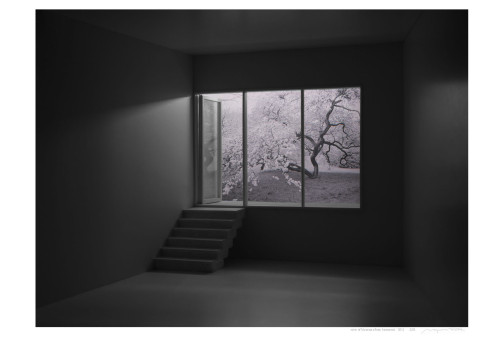
Mayumi Terada, photography.
One could not, I don’t imagine, accuse say a Kafka of writing narrative that functions as command, or a Dostoyevksi, or Herman Broch. Or Sebald or Thomas Bernhard. For the contours of form in the work of these writers, however varied their topics, is not just raising questions, or expressing uncertainty, but is also asking something about the forgotten collective history of humanity; those archaic traces both Freud and Adorno refer to and credit in the formation of all allegory. The kitsch narrative of your average MFA writer, however, tends toward — via form — something less expansive, narrower and in usually saturated with the ironic. Or that peculiar post modern ironic. Even the flat fetishized ‘concrete’, free of ideas, ends up ironic. For the neo-provincial mind, white mind anyway, of today is always ironic. A generation has matured unable NOT to express itself ironically.

Christian Hellmich
These works of fiction, those on the NY Times best-seller list, are work that is not only, usually, about the bourgeois view of the world, they are in their form expressions of what Debord referred to above; they function as this false ‘real’, they play their part in continuing the illusion.
There is much more to say about writing, the Lacanian ‘outside’, about the narratives of the state. Bill Blunden recently wrote:
“In 2006 journalist John Pilger spoke with Duane “Dewey” Clarridge, a CIA officer who supervised agency operations in Latin America back in the 1980s. Pilger queried Clarridge as to what gave the CIA the right to overthrow foreign governments, Clarridge responded[lxxvi]: “Like it or lump it, we’ll do what we like. So just get used to it, world.” There you have it. When they want something they take it. Native Americans can attest to the veracity of this statement. This, dear readers, is the mindset of the ruling class, the true face of empire.”

Binu Bhaskar, photography. “New Delhi”.
But I wanted to finally return to the narratives being applied to the new resurgent fascism. The IS narrative is designed to feed a larger strain of western narrative that suggests only the United States, and its minions, can solve such scary problems. The beheadings are the cinematic teaching aid, the better to zero in on the malignancy of all Arab culture and society. The lip service of the war mongering paternalistic left (Crabapple, Penny, et al) is about tolerance, but it really only promotes the deep superating wound of racism, and the rising new Colonialism.
Phil Greaves wrote, on the topic of Western narratives on Israel;
“Only a crude revisionist or devout partisan of the highest order is able to analyse the historical and present policies of Israel and its imperial backers and come to any other conclusion that the full expulsion and expropriation of the Palestinian people and their land is the desired end-goal.”
But this is obvious if only because Zionist leaders have openly said the same thing for decades. There are so many examples. The breakup of the former Yugoslavia, Haiti and Aristide, and of course the continuing NATO expansion and the various ‘color revolutions’ in the former Soviet republics. But none of this makes it into the Spectacle. Because the narratives of the Spectacle no longer have to be seen as factually correct. The narrative, the manufactured reality is the more real. The consumption of these narratives is what matters. They provide comfort, distraction, and the opportunity to shop for self definition. These are the new(ish) social rituals of culture. Art is being erased, in terms we once thought of it. The worship of success has meant that the creation of any cultural product or artifact is geared for immediate popularity. If something is too difficult, or perceived as somehow *unsuccessful*, it is the kryptonite for the culture shopper. The hipster class desires nothing so much as agreement with the status quo, even if it’s best to disguise that fact in the trappings of independent taste.
There is a lot of great work out there, but the audience for serious work has shrunk. Taste is conditioned by the most regressive psychically stultifying tendencies of mass media, by Murdoch owned propaganda machines and believe me, FOX does want the public to take culture seriously.
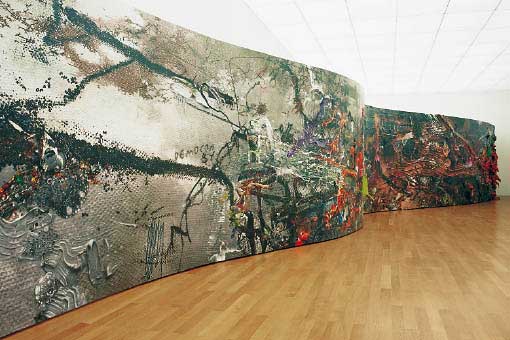
Fabian Marcaccio
There is a recognition, though, too, by the ruling class, that social unrest is growing. The constant repetition of zombie films and TV shows, of alien viruses and even, in the opening episode of the very odd Amazon produced TV series, Hysteria, a sort of auto-generated , ah, hysteria starts to strike the population, suggests an intuitive understanding of this. These shows and films are both expressions of fear from the class making them, but they find a welcoming audience too that senses there is something truthful about the center no longer holding. The cause of these crises is always from ‘out there’, it’s never caused by class tensions, by exploitation, or inequality. NEVER. It is always a bromide about scientific corruption (a bad apple) or corporate hubris, greed or some other banality. The new quasi-vampire TV series (from a comix, of course) is The Strain. There is one telling image, however; once a victim, infected, starts to turn, he or she loses their genitalia. In one episode the fledgling vampire’s penis falls into the toilet. It’s possible that white America has never quite so fully expressed its masculinity panic this well. But the fact is that life for tens of millions on the planet is much like life as a zombie. In the U.S. today, something like 80% of the population teeters on the edge of poverty. The working class no longer can imagine owning a home in most big cities. Unions are a thing of the past. The working conditions of Ciudad Juarez are increasingly those of most U.S. cities. That rich americans resemble drug cartel leaders is not surprising, and the appeal of vampire films is, I suspect now, that the bourgeoisie desire the chance to be blood suckers, too. Cartel bosses send their children to elite schools, same as American political elite, media elite, Saudi princes and Israeli gangsters. Money is respected. Nothing else. I saw recently a home for sale in Venice CA. It is a home originally bought as a Sears, Roebuck & Co.’kit’ house. A mail order pre fab bungalow. Today it is going for 2.5 million. And by today’s standards it’s a beautifully built house. Hardwood floors, spacious, lots of light. It originally sold for a couple thousand dollars. In the 1940s, or 30s, this was what one might expect. A livable affordable home. A unionized worker could probably afford it. But that time is long past.
http://la.curbed.com/archives/2014/09/1923_sears_roebuck_kit_house_in_venice_asking_25_million.php
A final thought. William Burroughs wrote a small book, really a compilation of bits and pieces, called Roosevelt After Inauguration. The final chapter is “Sects and Death”. He starts it by writing “I postulate that the function of art and all creative thought is to make us aware of what we know but don’t know we know”. I think most artists I know, the serious ones, agree with this. Burroughs then says the role of the church is to keep us in ignorance of what we know. But a paragraph later Burroughs writes what he considers a central need for all cults…
“Make enemies. If there is one thing a cult leader needs, it is enemies — real or imagined– from which to deliver his flock.” Create emergencies. Create commando squads to go deal with the emergency. The capitalist Imperialist United States is today a cult. It is the James Jones of nation states.And media is the Jones sermons blast over loud speakers throughout Jonestown. And the kool aid, the now famous kool aid, is, I guess, anti depressants, those 250 million people now addicted to anti-depressants, and the thirty million pain killer script written by doctors.

The Strain, FX, 2014. Created by Chuck Hogan, Guillermo del Toro.

Great article… before I reply in depth I just wanted to expand a bit on Marx’s (justly famous) quote about how history appears first as tragedy, then as farce. I think we can adapt that to our modern society of spectacle, which swallows almost all that passes as news, history and politics, where tragedy is impossible:
Spectacle repeats, first as melodrama, then as self-parody.
Great
“There is a recognition, though, too, by the ruling class, that social unrest is growing. The constant repetition of zombie films and TV shows, of alien viruses and even, in the opening episode of the very odd Amazon produced TV series, Hysteria, a sort of auto-generated , ah, hysteria starts to strike the population, suggests an intuitive understanding of this. ”
The fast zombies…
Check this out
.https://www.youtube.com/watch?v=92JCleCaCj4
The effects are really curious, we see now whom this affects and how
@molly
yeah, its fascinating that. Its sort of overdetermined………must think on it, actually.